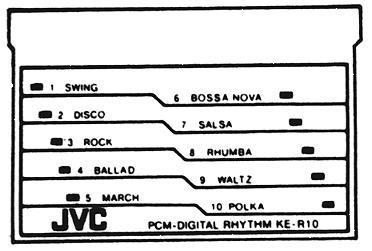

Description
The KB-808 must be the rarest of the KB series keyboards. In fact while
I've seen at least a handful of all the other KB models for sale I've yet
to see a KB-808. Likewise a websearch for all other KB models will bring
up at least a few bits of information, a search for the KB-808 brings up
nothing. The first I heard of it was a brief mention in an 80s Australian
music magazine's report of a industry show. If that was the only piece
of evidence I'd found I'd be tempted to say that it never got past prototype
stage and never went to sale to the public. But I was able to buy a copy
of the manual and have confirmation that the Lowrey rebadging, the Micro
Genie V-125, did in fact go in to production (see it on the V-125 page).
Both these factors would tend to suggest the KB-808 did get past prototype
stage.
The bad news is that the concept behind the KB-808 seems to be a bit flawed. The idea was to get a KB-800 and replace the sequencer cartridge (KE-10 Digital Composer) with a drum cartridge (KE-R10 PCM-Digital Rhythm Module). (Was JVC's choice of name a reference to Roland's TR-808 drum machine?). The problem is that they had to get rid of some very useful features to make room for, what turns out to be, a pretty unimpressive drum cartridge.
Some of the main features that were removed from the KB-800 are:
- You can not record your own auto-accompaniment patterns or "styles", you can only use the pre-recorded ones.
- The number of variations for the auto-accompaniment goes from 4 to 3, but most significantly you can't change the variation independently for each part (Arpeggio, Accompaniment, Bass, Rhythm (or drums), Intro/Fill-In), rather the variation you choose is global; it gets applied to all parts.
- Variation changes can not be recorded as part of a song in the Compucorder's memory.
- The effect send pots to the Digital Effector get replaced with effect on/off switches and the stereo pan pots for each part have gone.
So what features are added to the KB-808? A) you can put the drums through the Digital Effector and b) the addition of the drum cartridge.
So what does the KB-808 drum cartridge do? The KB-808 manual has no explanation of what the concept behind the drum cartridge is. I guess there was some separate instructions that came with the drum cartridge that would have told you that. At the least the cartridge must hold the drum pattern, but I wonder if it also holds patterns for the melodic accompaniment parts too. It would be a bit odd to buy a new cartridge with say a Jazz drum patten but the Disco melody parts still get used! Also the labelling seems to be hinting that the cartridge actually holds the sampled drums sounds, so that buying different drum cartridges would give you different percussion sounds. Now that would be super cool or course but I kinda doubt it's true. I don't think in 1986 they could have fitted the necessary chips into such a small cartridge.
So presumably the idea was you could buy addition cartridges that added either new drums patterns or whole new accompaniment styles. When you consider how rare the KB-808 is and that these kind of optional accessories are usually bought only by a small percentage of customers... well they must be very rare indeed! In fact I would not be surprised if these additional cartridges never actually saw the light of day as the KB-808 seems like it was probably a flop and come out right toward JVC's withdrawal from the keyboard/organ market.
The KB-808 is an interesting quirky keyboard to be sure but the unfortunate reality is that at the end of the day it's really just a less impressive KB-800.

Specifications
Keys: 61
Orchestral Presets
1st: (8) organ, jazz organ, electric piano,
trumpet, jazz flute, clarinet, piano, vibraphone
2nd: (6) string ensemble, brass ensemble,
harpsichord, vocal ensemble, synthesizer tone, hawaiian guitar
Switches: orchestra split, accompaniment
selector
Solo Synthe Presets
Voices: (8) trumpet, trombone, pan flute,
oboe, saxophone, synthesizer tone, piano, guitar
Switches: solo cancel, solo to arpeggio,
solo to bass
Digital Effector
Switches: delay, echo, flanger, long/short
(effects delay, echo and flanger)
Custom Memory
2 memories, each stores the following:
orchestral preset, orchestral split on/off, digital effector (delay, echo,
flanger, long/short), effects (orchestra sustain, organ tremolo), ultra
chord (open, closed), magic foot (intro/fill in, bend, sustain,
start/stop), fascinating chord (normal/one finger/multi
finger, chord memory, key split)
Effects
Switches: orchestra sustain on/off, organ
tremolo
Controls: orchestra sustain level, bass
sustain level
Ultra Chord: closed, open
Magic Foot (ie foot switch): intro/fill-in,
bend, sustain, start/stop
Full PCM Stereo Rhythm
Basic rhythms: (10 x 3 variations = 30)
swing, disco, rock, ballad, march, bossa nova, salsa, rhumba, waltz, polka
Switches: start/stop, synchro start, intro/
fill in, hand clap/tambourine, manual drums, tempo control
Fascinating Chord: normal, one finger, multi finger, chord memory, key transpose, key split, bass/extra bass selector, guitar / piano rhythm accompaniment voice selector
Compucorder (each selector represents 1
song, can be chained to form 1 song)
Selector 1 (48 bars)
Selector 2 (48 bars)
Selector 3 (32 bars)
chord record, melody record (selectors 1 and
2 record 384 notes, selector 3 records 256 notes), replay erase
Volume: rhythm, bass, arpeggio, rhythm accomp, accomp, orchestra, solo, master volume
Back panel: AC in, AUX OUT R/L, AUX IN R/L, expression pedal, foot switch, headphones, MIC IN, MIDI IN, MIDI OUT, MIDI thru, MIC Volume, Main Pitch, Solo Pitch, Voltage selector
Power Supply: AC 120/220/240 V switchable, 50/60 Hz
Amplifier Output: 4.0 W x 2
Speakers: 14 cm x 2
Weight: 11.3 kg
Dimensions: 950(W) x 104(H) x 330(D) mm
Power Consumption: 46 W
Provided Accessories: AC cord, owner's
manual, KE-R10 PCM rhythm module, KF-10 foot switch
Optional Accessories: KC-20 soft carrying
case, KS-10 keyboard stand, KX-20 expression pedal